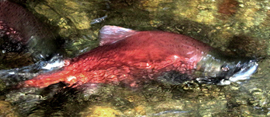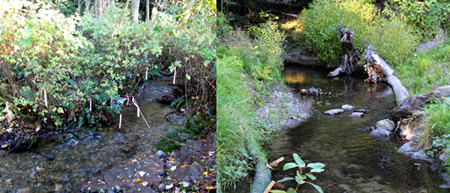
Vision: Viable runs of native Lake Washington Basin kokanee in McAleer and Lyon Creeks by 2026
Report a Salmon Sighting Here!
Background
 Lake Forest Park, like many towns in the west, has stories of the olden days in which salmon were stacked like cordwood in local streams. Our streams have a special distinction in having had an abundance of kokanee salmon, remembered as “the plentiful Little Red Fish that were unique to the area.” (1). Kokanee salmon are a variety of the better known Sockeye salmon that have become landlocked – their entire life cycle takes place in fresh water. Newly hatched kokanee quickly move downstream and spend approximately three years in a large lake before returning to spawn in their stream of origin. Kokanee have evolved multiple times in different places, usually in cases where glaciers or shallow wetlands have blocked access to the ocean. In the Lake Washington/Sammamish basin there were at least three distinct runs – an “early” run and “late” run found in Lake Sammamish, and a “middle-run” found in many tributaries of the Sammamish river and Lake Washington – including McAleer and Lyons creeks. The “early” run was declared extinct around 2000, the “late” run has been the focus of intense and successful restoration efforts involving local, state, federal, and tribal programs (see ), and the status of the “middle” run is officially uncertain. The situation for the middle run is complicated because population sizes are highly variable, there is the possibility that our local kokanee have interbred with sockeye or kokanee populations introduced from elsewhere, and introduced populations of sockeye occasionally produce individuals that don’t bother to go out to sea (these are called “residuals” to distinguish them from true kokanee).
Lake Forest Park, like many towns in the west, has stories of the olden days in which salmon were stacked like cordwood in local streams. Our streams have a special distinction in having had an abundance of kokanee salmon, remembered as “the plentiful Little Red Fish that were unique to the area.” (1). Kokanee salmon are a variety of the better known Sockeye salmon that have become landlocked – their entire life cycle takes place in fresh water. Newly hatched kokanee quickly move downstream and spend approximately three years in a large lake before returning to spawn in their stream of origin. Kokanee have evolved multiple times in different places, usually in cases where glaciers or shallow wetlands have blocked access to the ocean. In the Lake Washington/Sammamish basin there were at least three distinct runs – an “early” run and “late” run found in Lake Sammamish, and a “middle-run” found in many tributaries of the Sammamish river and Lake Washington – including McAleer and Lyons creeks. The “early” run was declared extinct around 2000, the “late” run has been the focus of intense and successful restoration efforts involving local, state, federal, and tribal programs (see ), and the status of the “middle” run is officially uncertain. The situation for the middle run is complicated because population sizes are highly variable, there is the possibility that our local kokanee have interbred with sockeye or kokanee populations introduced from elsewhere, and introduced populations of sockeye occasionally produce individuals that don’t bother to go out to sea (these are called “residuals” to distinguish them from true kokanee).
 LFPSF supports kokanee restoration efforts in Lyons and McAleer creeks. These creeks are excellent candidates for kokanee restoration for a variety of reasons, including:
LFPSF supports kokanee restoration efforts in Lyons and McAleer creeks. These creeks are excellent candidates for kokanee restoration for a variety of reasons, including:
- There are very few salmon in these streams now to compete with or complicate kokanee restoration
- The streams are small, and the portions of both streams pass through public/city property that allows easy access for monitoring
- There has recently been a major culvert restoration (under 522) and habitat restoration creating quite a bit of accessible spawning habitat.
- Although it arises in Snohomish county, most of the relevant habitat is in King county and is, in fact, within the single municipality of Lake Forest Park so municipal and community engagement would be streamlined.
- There is a very active community environmental community in Lake Forest Park, with a track record of fundraising, advocacy, environmental permitting and restoration, habitat monitoring and volunteerism
- Relative to most urban/suburban streams, the McAleer and Lyons creeks watersheds have an extensive tree canopy
Because the status of the middle run of kokanee is uncertain, we envision restoration occurring in two phases:
- Phase 1 (4-6 years): Documenting the origin and status of North Lake Washington kokanee populations and assessing the suitability of Lyons and McAleer creeks as kokanee spawning habitat
- Phase 2 (4-6 years): Supplementation of kokanee populations through some combination of stream enhancement, egg box rearing, hatchery rearing, introduction of fry
During the course of the project we will transition from planning and fundraising to monitoring ( e.g. stream conditions, fry survival, and adult returns) as circumstances warrant.
Current Status
The successful efforts of the Lake Sammamish Kokanee working group (2) serve as an excellent model for our restoration plans. We have discussions underway with the Kokanee Working group, county, state, federal, and UW fisheries biologists, local environmental organizations that share our interest in restoring middle-run kokanee (e.g. PERK, Friends of North Creek Forest), LFP citizens, and environmental stewards who have long been active in our community (e.g. Streamkeepers). Monitoring of LFP stream conditions and salmon returns, with a special eye towards kokanee, will begin in Fall 2016.
How you can help!
- If you share our interest in returning our “little red fish” please share your interest with your neighbors, your local government, and with us!
- If you own property along the stream and are will to allow access to survey the stream, let us know! We’ll be sensitive of and respectful to your property.
- If you see a salmon in our streams, let us know by reporting it here! Stream monitoring is a time consuming and difficult process. The more eyes we have on the stream, the better. Pictures and complete descriptions are great, but even information about a salmon that you glimpse but can’t identify is useful.
- If you see something occurring that might impact salmon, or stream health more generally, please report it here. That can include obvious things like pollution or construction activities along the stream, or less obvious but still important impacts such as excessive or unpermitted tree removal.
References
1. Growing up with Lake Forest Park : the early decades in “North Seattle” Barbara L. Drake Bender 1983 Edmonds, WA : Creative Communications. Contains a wealth of recollections of life in early LFP, including multiple references to kokanee.
2. http://www.kingcounty.gov/environment/animals-and-plants/salmon-and-trout/kokanee/kokanee-workgroup.aspx. Tons of great info in here.
Photo Information.
- Header image:Sockeye salmon in McAleer Creek, 2004.
- Kokanee spawning in Ebright Creek, Lake Sammamish watershed, 2015. Photo credit: Jeffrey S. Jensen
- Flagging tape marks the location of redds (spawning sites) of kokanee salmon in Ebright Creek (on left), a creek similar in size to Lyon Creek (on right). Photo credits: Jeffrey S. Jensen
